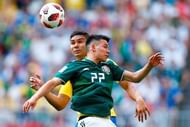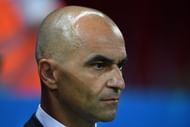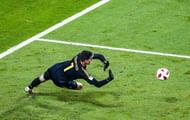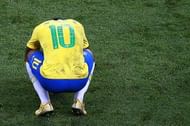The 2018 World Cup has left us spoiled for choice when it comes to great games. Personally, however, yesterday had my favourite game of the tournament as favorites Brazil were shocked by a talented Belgium side.
It was a game that had everything: a lucky goal (Belgium’s first), exceptional counter-attacks, the brilliance of Kevin De Bruyne and Romelu Lukaku, great goalkeeping etc. It was also a game that revealed a lot about the two teams and this entire tournament.
On that note, here are five takeaways from the fixture:
The Counter-Attack is the Tactical Trend of this World Cup

In 2006, it was Italian Catenaccio. In 2010, it was Spanish tiki-taka. In 2014, it was German gegenpressing. Usually, the tactical trends that dominate a World Cup are preceded by the dominance of a few clubs before the competition. In the four years before 2006, Juventus and Milan dominated Europe with their defensive style. The years before 2010 saw the emergence of Pep Guardiola’s Barcelona who won the treble in 2009. Bayern Munich dominated the Champions League between 2012 and 2014 with Jupp Heynckes’ pressing style working wonders.
2018 is strange in the sense that there doesn’t seem to be one tactical style that was prominent in the Champions League over the past four years. While Real Madrid have won three of the past four Champions Leagues, they do not have a defining tactical style apart from “have the best midfielders” (Isco, Luka Modric and Toni Kroos) and the best striker (Cristiano Ronaldo).
Instead, what we have seen in Russia is the return of the counter-attack. It never really went away, but the initial emergence of tiki-taka had meant that most teams which tried to sit deep and wait for the counter-attacks were just overwhelmed.
However, elite International teams do not have the synergy of elite club teams and thus often are vulnerable to counter-attacks. Germany’s exit in the World Cup can primarily be attributed to this as all three of their group opponents overwhelmed Die Mannschaft on the counter. Argentina were crushed by both Croatia and France in a similar manner.
This continued yesterday when favorites Brazil were continuously exposed by Belgium’s counter-attacks, especially in the first half. Kevin De Bruyne and Romelu Lukaku combined on multiple occasions, notably for Belgium’s second. The Red Devils’ fluky first came from a corner earned after an excellent counter.
In fact in the knockout stages, 7 of the 10 teams that have progressed to the next stage have spent more time in their own third than their opposition’s (6 out of 10 have had less possession). It’s been around for years, but sitting deep and counter-attacking still works.
Casemiro is extremely underrated

What made the Selecao so vulnerable on the counter-attack was the absence of their brilliant defensive midfielder Casemiro (due to a suspension). Brazil weren’t significantly troubled by Mexico’s counters in the Round of 16 (when Casemiro played) but were ruthlessly exposed by Belgium’s. Some of that has to do with Belgium’s superior talent, but one can’t shake off the feeling that Brazil wouldn’t have been so vulnerable with Casemiro in the side.
Statistics bear this out - in the Mexico game, Casemiro made six tackles and three clearances. Against Belgium, his replacement Fernandinho only made one tackle (though he did have more interceptions). It is no coincidence that since Casemiro has become a regular starter for Real Madrid, the team has won three Champions League titles. With him and Fernandinho, Brazil have two of the world’s best defensive midfielders.
Martinez got it right, Tite didn’t

Roberto Martinez has gotten a lot of stick for his tactical decisions this World Cup as the decision to play Yannick Carrasco and Thomas Meunier as wing-backs has been criticized endlessly. However, even his biggest critics (including yours truly) have to admit that his tactics were spot on against the Selecao. Martinez decided to play Nacer Chadli instead of Carrasco and he was more solid defensively (at least in the first half) while also providing two key passes.
Martinez’s other major tactical decision was to drop Dries Mertens and play Marouane Fellaini in midfield. This helped provide more defensive solidity as Fellaini and midfield partner Axel Witsel showed a surprising ability to contain the Brazilian midfield. In fact, Fellaini made three tackles, two interceptions, three clearances and one blocked shot - defensive statistics matched by no one else in the side. Yet, the more important impact of that decision was how it freed up Kevin De Bruyne. De Bruyne was the best player on the pitch while also scoring an absolute worldie.
It was a tale of two managers as Brazilian coach Tite made several regrettable decisions. The selection of Gabriel Jesus was questionable considering his poor form earlier in the tournament. Moreover, in the absence of Casemiro (and considering Belgium’s attacking talent), Tite should have considered dropping Paulinho for a more defensively minded midfielder (like Fred). Brazil looked far more dangerous in the second half when Roberto Firmino and Douglas Costa were on for Jesus and Willian. By that time, it was too little, too late.
Goalkeepers and luck decided the game

For all the discussion surrounding the emergence of the counter-attack, the importance of Casemiro and managerial decisions, it was really goalkeepers and luck that decided the game.
Goalkeeping was not as influential in this game as France vs Uruguay but still retained an important role. At one end, Thibaut Courtois played the game of his life as he made save after save as Brazil lay siege to the Belgian goal (especially in the second half) - his last-minute save from Neymar's strike was excellent. In fact, the Chelsea goalkeeper had the highest WhoScored player rating of anyone in the game.
On the other end, Alisson did not make any glaring errors as compared to Fernando Muslera earlier in the day. However, the Roma goalkeeper was unconvincing throughout and could have done better for Belgium’s first. It would be no exaggeration to suggest that the result of this game would have been different if the goalkeepers had been swapped.
The other major factor that decided this game was luck - on another day, Brazil would have won this game 2-1. On another day, Thiago Silva’s shot in the 8th minute would have bounced back in off the post. On another day, Fernandinho’s header would have cleared Belgium’s corner rather than sending it into his own net. On another day, Phillippe Coutinho’s curler in the 37th minute would have ended up in the top right corner. On another day, Roberto Firmino would have reached Marcelo’s cross. On another day, Brazil would have gotten a penalty.
South American football needs fixing

Brazil’s exit means that South America’s participation in the World Cup has finished. It almost feels like an overreaction to say that South American football needs to be ‘fixed’ after one tournament. However, it marks the continuation of a trend. In the last four World Cups (including 2018), South American teams have only formed three of the 16 semi-finalists, one of the eight finalists and none of the four winners.
This is despite the fact that the continent’s teams have included the likes of Lionel Messi, Neymar, Ronaldo, Ronaldinho, Kaka, Coutinho, Sergio Aguero, James Rodriguez, Alexis Sanchez and Arturo Vidal. Thus, it isn’t the production of talent that is the problem in the continent. Instead, it is the lack of tactical ideas that have come from the region.
Most of the breakthroughs in football over the last decade have come from Europe, something that was not true in the 1970s and the 1980s. That will have to change if South America are to do better in future World Cups.
